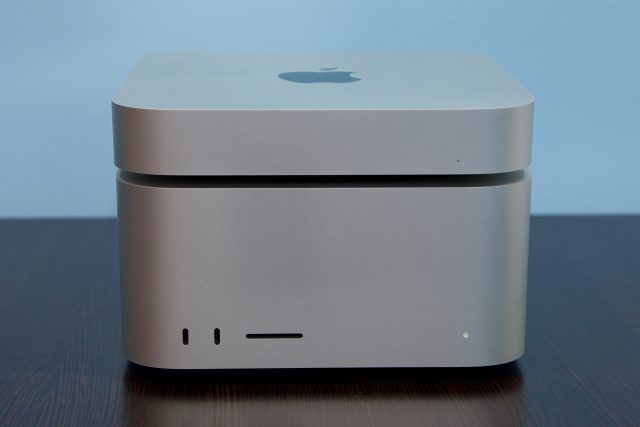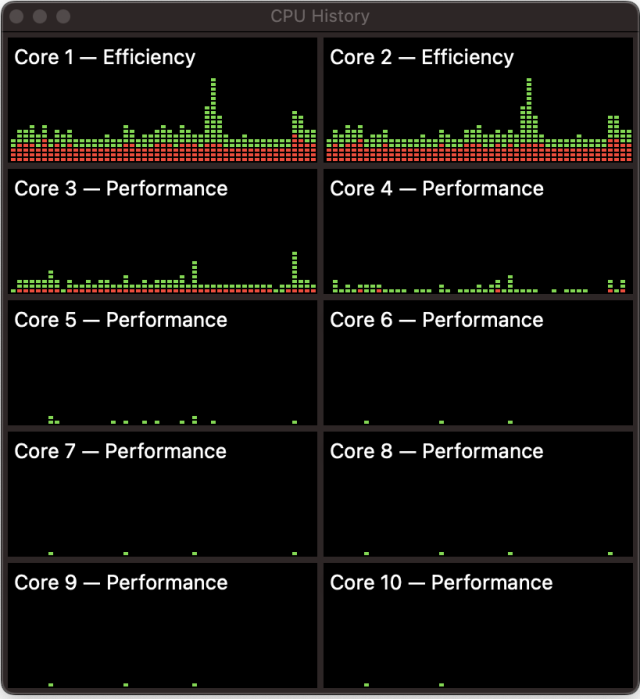Power efficiency: Apple Silicon demolishes Intel
-
Andrew Cunningham
-
Andrew Cunningham
Both the M1 Max and M1 Ultra are objectively strong performers, but the whole-system power consumption numbers we recorded are where Apple’s chips really impress.
Both the power-unlimited Core i9-12900 and the M1 Ultra performed roughly the same in our Handbrake video-encoding test, and the i9 did even better than the M1 Ultra in a handful of our CPU benchmarks. But measured at the wall, the Core i9 PC was drawing roughly 300 W of power the entire time the encoding task was running compared to the mid-80s for the M1 Ultra.
Reining in the Intel chip and making it use Intel’s stock power settings makes the Core i9 much less power-hungry, and it still handily outperforms the M1 Max in that scenario even as it falls behind the M1 Ultra. But even then, full-system power draw is roughly 130 W compared to about 47 W for the M1 Max version of the Studio. These are also the numbers to look at if you want to compare Intel's latest NUC Extreme to the Mac Studio—it's the closest to the Studio's size and performance that you can get in an x86 desktop computer right now.

If anything, these numbers make it seem like Apple could have made the performance of both Studio models even better by raising the chips’ clock speeds a bit at the expense of a little extra power use. The M1 chips could use twice as much power as they do and still stack up favorably to Intel’s CPUs. But as we’ve seen with Intel’s Alder Lake chips (or even the M1, which delivers the best performance-per-watt by far in this test), you definitely don’t get 200 percent of the performance just because you're using twice as much power. Apple’s chip design team seems acutely aware of those diminishing returns and has tuned all of its M1 chips accordingly.
What makes this even more impressive is that the M1 is a year-and-a-half-old CPU architecture built on TSMC’s 5 nm process, and Intel’s CPUs are recent releases built on a 10 nm process that the company struggled with for years. With an M2 series built on TSMC’s 4 nm process allegedly right around the corner, it’s hard to see how Intel will close this gap in the short term.
Which one to pick, and the significance of single-core performance

It’s remarkable just how consistent Apple has decided to make single-core performance across the entire M1 lineup, from the M1 itself to the Ultra. All the chips performed identically in every one of our single-threaded benchmarks every single time.
This has big implications for day-to-day use. Most of what we perceive as “responsiveness” in a phone, tablet, or computer still comes down to single-threaded CPU performance—processors need to handle a bunch of separate, individual tasks more often than they need to do one big job that can be evenly split among all its CPU cores.
Also consider the way that macOS divides tasks between the M1’s performance and efficiency cores. Even on an M1 Max or M1 Ultra, if you’re just browsing and working on documents and typing in Slack or Discord and listening to music in the background, a look at Activity Monitor will show you that it’s the efficiency cores that are handling the lion’s share of those tasks. Performance cores are definitely pitching in when they’re needed, but in this fairly representative screenshot, you’ll see that most of them are just sitting there waiting for work to do.

So if you’re waffling between the Max and the Ultra versions of the Studio and you don't regularly compile code in Xcode, encode video, or do high-end rendering tasks, save yourself the money and skip the Ultra. For workloads lighter than those, you aren’t likely to notice the difference very often.
Even the M1 Mac mini I use as my daily driver doesn’t feel too different in day-to-day use than either of the Studio models. I know that the Studio is faster because I have the numbers telling me it is, and when I’m working with huge photos or video files, I can occasionally feel it. But most of the time—by Apple’s design—all of these computers will feel pretty similar, and you should resist the urge to overspend in the name of future-proofing.
It’s when you’re working with multi-gigabyte graphics, 4K or 8K video projects, or complex After Effects or Final Cut rendering projects that you’ll really benefit from the extra CPU, GPU, and RAM of a Studio—not if you just want a desktop that feels zippy for everyday work.
reader comments
578